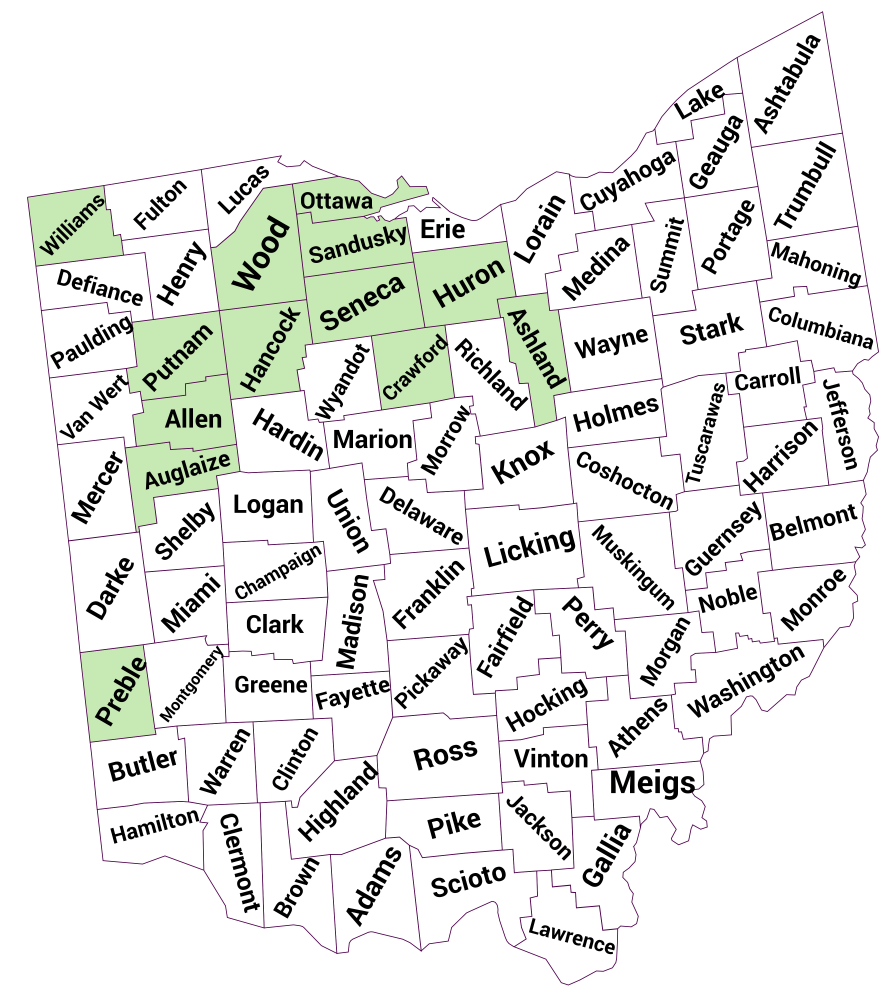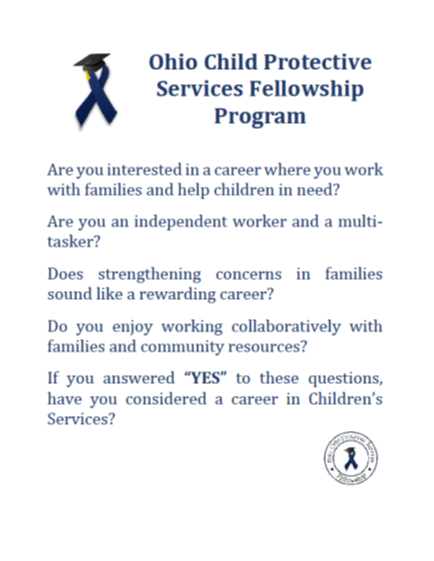Spotlight on Innovative Recruitment Strategies: Northwest Ohio Fellowship Program
 Ohio is a county-administered children services (formerly known as child welfare) system. Like many other states, Ohio is experiencing a shortage of child protective services (CPS) workers. County leaders report that this is due to high rates of turnover compounded by rising wages and competition from outside employers. Traditional recruitment techniques and programs, including traditional partnerships with universities with social work programs, are not adequate to meet the current level of need for new children services workers. Although social work majors come to children service agencies with a training set that allows faster onboarding, social work majors make up less than 50% of CPS workers in many Ohio counties. A collaborative of 13 counties in northwest Ohio, led by Wood County, is working to pilot a new technique to engage college students and develop a path to careers in CPS. The pilot operates in partnership with the State of Ohio Department of Job and Family Services (ODJFS) and the Greater Ohio Workforce Investment Board.
Ohio is a county-administered children services (formerly known as child welfare) system. Like many other states, Ohio is experiencing a shortage of child protective services (CPS) workers. County leaders report that this is due to high rates of turnover compounded by rising wages and competition from outside employers. Traditional recruitment techniques and programs, including traditional partnerships with universities with social work programs, are not adequate to meet the current level of need for new children services workers. Although social work majors come to children service agencies with a training set that allows faster onboarding, social work majors make up less than 50% of CPS workers in many Ohio counties. A collaborative of 13 counties in northwest Ohio, led by Wood County, is working to pilot a new technique to engage college students and develop a path to careers in CPS. The pilot operates in partnership with the State of Ohio Department of Job and Family Services (ODJFS) and the Greater Ohio Workforce Investment Board.
The premise of the Ohio Child Protective Services Fellowship program is that the state could create a pipeline of incoming talent for students with degrees related to social work such as psychology, family science, sociology, and criminal justice. The goal of the pilot is to test the ability to recruit, retain and train students using a fellowship/apprenticeship model.
How Does it Work?
 The fellowship program partners with universities to recruit students entering their junior or senior year of college. Recruiting tools include fliers, cards, career day events, Facebook advertisements, speaking directly to students in classrooms, and networking with university departments. Fliers highlight that it is a paid fellowship with hands on experience, up to 120 hours of training, and that it requires a two-semester commitment and 20 hours a week of work. Prospective students participate in an interview, virtual reality experience, ride along with a caseworker, and a conversation with a county representative to determine if the fellowship is a good fit for them.
The fellowship program partners with universities to recruit students entering their junior or senior year of college. Recruiting tools include fliers, cards, career day events, Facebook advertisements, speaking directly to students in classrooms, and networking with university departments. Fliers highlight that it is a paid fellowship with hands on experience, up to 120 hours of training, and that it requires a two-semester commitment and 20 hours a week of work. Prospective students participate in an interview, virtual reality experience, ride along with a caseworker, and a conversation with a county representative to determine if the fellowship is a good fit for them.
Students receive training and work part-time at one of Ohio's public children's services agencies (PCSAs) (entities that assess and investigate reports of child abuse, neglect, or dependency as required by state law) while they are still in school. As part of the fellowship, students are county employees and able to transport clients and children, supervise visits, request records, document case information, shop for clients, help with placements, and do follow up calls with providers and clients.
The program relies on a Fellowship Coordinator who is responsible for recruiting students and monitoring their progress throughout the program. Each participating PCSA trains and mentors the student workers, participates in monthly coordination meetings, and provides information to the Coordinator.
The Quality Improvement Center for Workforce Development (QIC-WD) partnered with Wood County and ODJFS to come alongside the program and support the evaluation. Together, they are tracking information related to students who show interest in the program and who apply for the program. The QIC-WD worked with the team to develop an excel file to track information about each person who applies and is hired for the program, their activities and performance in the program, and ultimately (when they complete the program) where they are employed and how long they are retained. ODJFS will follow the fellows and compare their movement through the agency as well as exits from the agency compared to regular hires.
As of June 1, 2023, 17 students participated. Of those 17 fellows, 11 remain active (meaning they are working in CPS as part of the fellowship program) and six have exited the program. Five (of the six who exited), were offered full-time employment (of which three were hired, one declined, and one is pending acceptance) and one was fired for non-attendance. Students involved in the program are gaining real-time field experience and career exposure and have a realistic idea of what a career in children services would be like for them. CPS is able to assess student interest in this field and to develop a support network for new workers.
 The team has learned valuable lessons about operating this program:
The team has learned valuable lessons about operating this program:
- The original concept of the project was based around recruiting talent and providing training prior to fulltime employment. The team learned that students need to apply for jobs when there is an opening, which may be before the student has completed the program or graduated. The county and student work together to make decisions about applying for CPS positions which can result in a student being hired before their last semester of college.
- Over time, many of the team’s assumptions about training and hiring were shown to be incorrect. For example, cohort groups were almost impossible to create due to scheduling, therefore, recruitment for the fellowship program was changed to be ongoing, not structured around a recruiting cycle.
- Many students will be hired before completion of the program, but they will have completed at least some core training and gained useful experience.
- State workforce dollars are essential to the program and students need to be reimbursed for their mileage.
- Counties involved need to follow the same script in talking about and implementing the program.
- Students are very motivated to apply and begin working in children services agencies. CPS agencies need to move rapidly to engage students, or they will lose them because the students will move on to another opportunity.
- Paid Facebook advertising (targeting 18–24-year-olds in certain zip codes) was one of the most effective recruiting strategies used by the counties.
This pilot program is testing the ability of Ohio CPS agencies to create a pipeline of incoming talent from a broader set of college programs (outside of social work). It will provide important metrics and proof of concept testing, to determine successes and obstacles to scalability. The hope is that this program not only expands the pipeline of potential employees into caseworker positions but leads to hires that are more informed and a better fit for the job who will remain employed longer and perform better as they work with families and children.